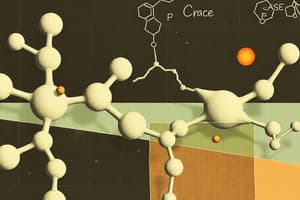Podcast
Questions and Answers
What are the four major classes of biological macromolecules?
What are the four major classes of biological macromolecules?
- Proteins, nucleic acids, vitamins, and lipids
- Carbohydrates, lipids, proteins, and nucleic acids (correct)
- Carbohydrates, lipids, proteins, and vitamins
- Lipids, proteins, nucleotides, and carbohydrates
What is the byproduct of the dehydration synthesis reaction when monomers combine to form polymers?
What is the byproduct of the dehydration synthesis reaction when monomers combine to form polymers?
- Oxygen gas
- Carbon dioxide
- Water molecules (correct)
- Nitrogen gas
What type of bonds do monomers form with each other to create polymers?
What type of bonds do monomers form with each other to create polymers?
- Covalent bonds (correct)
- Ionic bonds
- Polar covalent bonds
- Hydrogen bonds
What elements are biological macromolecules bound to, in addition to carbon and hydrogen?
What elements are biological macromolecules bound to, in addition to carbon and hydrogen?
What does the term 'dehydration synthesis' mean?
What does the term 'dehydration synthesis' mean?
What is the stoichiometric formula for carbohydrates?
What is the stoichiometric formula for carbohydrates?
In carbohydrate molecules, what is the ratio of carbon to hydrogen to oxygen?
In carbohydrate molecules, what is the ratio of carbon to hydrogen to oxygen?
What are the three subtypes into which scientists classify carbohydrates?
What are the three subtypes into which scientists classify carbohydrates?
In aqueous solutions, in what form do monosaccharides usually exist?
In aqueous solutions, in what form do monosaccharides usually exist?
Around the anomeric carbon in the ring form of glucose, how many different hydroxyl group arrangements can exist?
Around the anomeric carbon in the ring form of glucose, how many different hydroxyl group arrangements can exist?
Flashcards are hidden until you start studying
Study Notes
Biological Macromolecules
- Four major classes: carbohydrates, proteins, lipids, nucleic acids.
Dehydration Synthesis
- Byproduct is water (H2O) during the combination of monomers to form polymers.
- Involves the removal of a hydroxyl group from one monomer and a hydrogen atom from another.
Bonding in Polymers
- Monomers form covalent bonds with each other to create polymers.
Composition of Biological Macromolecules
- Biological macromolecules are composed of carbon, hydrogen, oxygen, nitrogen, sulfur, and phosphorus.
Definition of Dehydration Synthesis
- A biochemical process where monomers combine, releasing water and forming polymer chains.
Carbohydrates
- Stoichiometric formula: (CH2O)n, where n is the number of carbon atoms.
- Ratio in carbohydrate molecules: 1:2:1 (one carbon to two hydrogens to one oxygen).
Classification of Carbohydrates
- Classified into three subtypes: monosaccharides, oligosaccharides, polysaccharides.
Monosaccharides in Aqueous Solutions
- In aqueous solutions, monosaccharides typically exist in cyclic forms.
Hydroxyl Group Arrangements in Glucose
- Around the anomeric carbon in glucose, two different hydroxyl group arrangements can occur (α and β configurations).
Studying That Suits You
Use AI to generate personalized quizzes and flashcards to suit your learning preferences.




